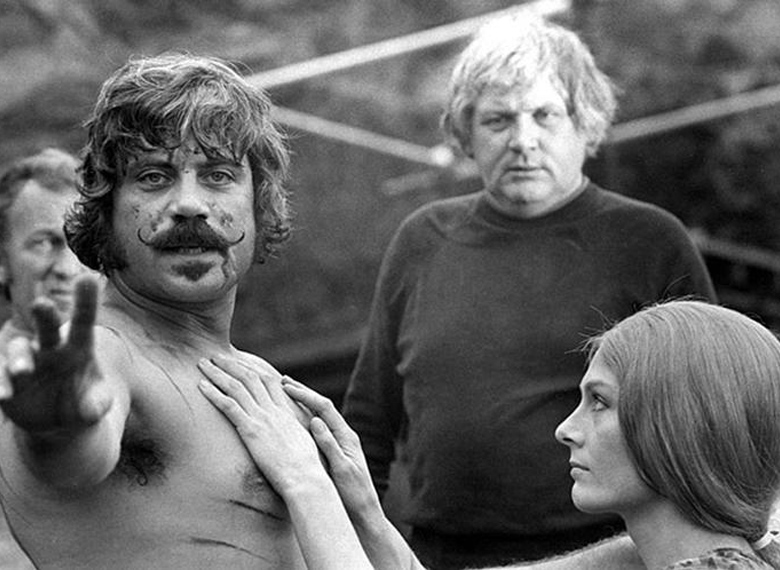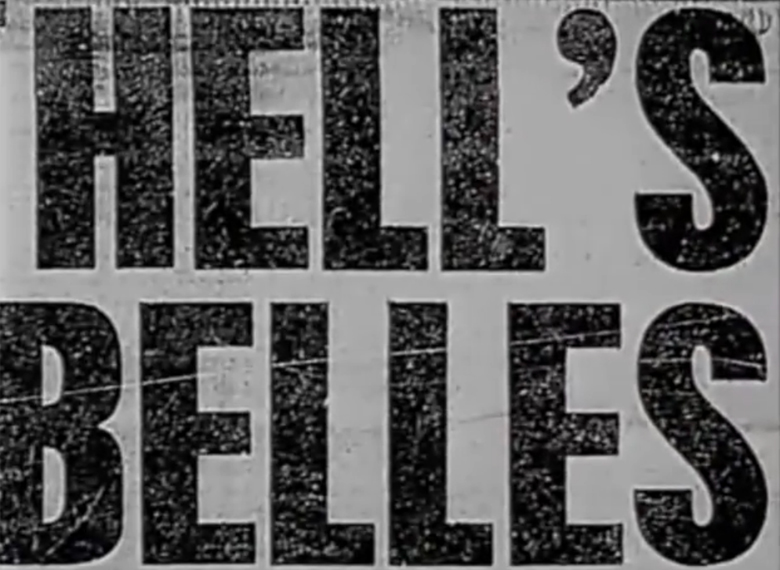A witch hunter shows the king his work: a writhing horde of women possessed, victims he will save from the devil. The king offers his humble, divine help: an ornate jewelled box, containing the blood of Christ. The witch hunter accepts it, gratefully. He presses the box to an agonized nun squirming on the ground. She, with the rest of the women, stop shrieking. They appear suddenly cured. The witch hunter proclaims to the king the power of the church, and the king begins to laugh. He takes the jeweled box back from the priest, and slowly opens it, pouring out the air within. The crowd begins to laugh. The witch hunter stares, “What sort of a trick have you played on us?” he asks his king. “Oh, reverend sir,” says the king, “What sort of a trick are you playing on us?”
The original 107 minute X-rated British cut of Ken Russell’s controversial film, The Devils (1971) is set to be screened on DVD for the first time in Calgary on October 25th 2018 as part of the Calgary Cinematheque’s forthcoming season. In keeping with the film’s status as a locus for discussions around censorship, Warner Bros. Entertainment Inc. sent Luma Quarterly an official letter denying the publication license to use any stills from the film. To this day, the film is still banned in some countries and censored in others, oozing a camp aesthetic and challenging the themes of puritanism and traditional marriage. Perhaps for these reasons, The Devils, along with Russell himself, have earned admiration from gay audiences.1Russell puts on a big, wild show characteristic of his later works, like Tommy (1975), and Altered States (1980).
It would be wrong to say that this film is historically faithful, as its exaggerated, frenetic tone rids it of any fidelity. Somewhat based on both the 1952 novel The Devils of Loudon by Aldous Huxley, The Devils depicts the historical account of the 1632 witchcraft trial of Father Urbain Grandier (Oliver Reed), with staged dream-like sets designed by the filmmaker Derek Jarman. The trial itself becomes a kangaroo court, and remains only one of the many theatrical ‘shows’ put on within the film as demonstrations of power.
Perhaps this is what is so horrific about the film, the fact that it takes such pleasure in treating its characters so cruelly, but also in part makes the viewer responsible.
Grounds for the trial begin as Abbess Jeanne (Vanessa Redgrave), like most women in the film (and what is most strenuous on the film’s suspension of disbelief), falls for Father Grandier. A series of fantasies appear before her; he appears walking across a lake, and she goes to him, her hair loose and free; she sees Christ on the cross transform into Grandier, and she licks the wound in his side. Her dreams of Grandier are steeped in the Christian faith, and the stifled sexuality that goes with it. She pines after him most of the film, writing him a letter inviting him to the convent, and is distraught by the news of his marriage. When she becomes absolutely frustrated, her attempts to get near him having failed, she says she’s been possessed, and names Grandier as the cause. Jeanne’s fantasies are then used against her. The Baron de Laubardemont (Dudley Sutton) uses her as a prop in his show designed to convict Grandier and oust him politically. Her body is tortured, used, humiliated, all before a masked audience. What begins as Jeanne’s personal fantasies becomes a tool for the Baron. These scenes are the most upsetting of the film. Not only does she have her passion whipped out, she is put on display. The people in masks point, they laugh. Perhaps this is what is so horrific about the film, the fact that it takes such pleasure in treating its characters so cruelly, but also in part makes the viewer responsible.
In Jeanne’s fantasy of Grandier coming off the cross, she leads her sisters in prayer, and goes to sit in front of the cross. She sits in front of the camera, facing us, the audience. She appraises Christ, while appraising us; Jesus hangs on the fourth wall. The film cuts to Jeanne’s point of view, seeing what she sees: Christ transforming into Grandier. The scene is built cutting between the fantasy and Jeanne’s reactions. This shot and reverse-shot oscillates the viewer between both being Christ, and being subject to Christ. Jeanne then technically worships both the viewers themselves, as well as the fantasy of Grandier-Christ. In doing so, both the fantasy image and the viewer are made divine, but Jeanne is not. She remains subject to both, as if both control her through a two-way mirror. Jeanne, Grandier, and the rest of the cast of characters within the film, are subjects to the imaginary divine image and to the viewer’s supposed gaze. It is not so much the image seen that they are slave to, it is the image not-seen, or only that is only seen by one person and never truly instantiated. Jeanne’s fantasies, and Christ himself, are never ‘seen’ in the film’s physical diegesis, but remain in the character’s imagination. This image not-seen provides the gap exploited by the Baron and the witch hunter. When asked why the witch hunter speaks to the demons in English and not Latin, he responds to the king by saying, “There are educated and uneducated devils.” The king cannot contradict this, since the priest seems to be the only one capable of perceiving the devils; all the king sees are nuns in pain. The demons are only present insomuch as the nuns are. The spectacle accounts for their existence. The truth, that all the nuns are being forced to sign confessions condemning Grandier, on top of going wild in service of a political agenda, is hidden by the simple explanation that they are possessed. However, the masked audience doesn’t care much for the truth. They are there for the show.
It implicates you in the sexual spectacle, through the conscious inclusion of audiences within the film’s diegesis.
What we, the actual audience, do see is a hyper-sexual film. Sex is forbidden to members of the church, and the film plays with this, since it subsequently pops up nearly everywhere. Grandier himself does not take his vow of celibacy seriously, gaining a promiscuous reputation. But unlike other camp-exploitation films—the films of Russ Meyer come to mind—The Devils does not let the viewer off the hook. It implicates you in the sexual spectacle, through the conscious inclusion of audiences within the film’s diegesis. The most apparent example is the scene lovingly referred to as “The Rape of Christ” in which a crowd of ‘possessed’ nude nuns scramble a statue of Christ off a wall, and proceed to have their way with it—as a priest watches, pleasuring himself. This two-and-a-half minute scene, cut from the British X-rated version to be screened at Cinematheque, is voyeuristic, but the implication of the priest transforms it somewhat. Rather than give liberty to anyone who would wish to just indulge in watching the scene, the film intercuts the priest’s orgiastic face, as if turning a mirror to the viewer, forcing them to confront the image of themselves watching. It shows the pleasurable (in sheer absurdity), but also the pleasured. If the scene did not include the priest, the audience would simply fill in his role, unaware.
Another earlier scene, Jeanne of the Angels is tortured publicly in the name of cleansing her spirit, and a crowd wearing black masks watches. This masked audience echoes the film’s audience, whose anonymity is also preserved. Both watch the scene without confrontation or consequence. The film explores spectacle itself as a mask, drawing attention to the protective veil of the safe but entertained Audience, and examining the greater mask—the fantastic spectacle of a trial so grand it masks darker political motivations.
What drives both of these performances is power—the power of the church, and the power of the state. As the film continues however, these performances become wilder and wilder, spinning out of control until they are spectacular.
Not free of duality himself, Father Grandier’s approach to priesthood begins as pure performance, as he indulges in earthly pleasures (riches, political power, women) even though he’s a member of the clergy. Grandier does so as a death-wish, indicating that he has “a great need to be united with God,” which seems to indicate his own possible skepticism of God’s existence. If a living priest does not already feel close to God, the film hints, perhaps there is no man behind the curtain. King Louis XIII (Graham Armitage) seems aware of the void as well, as he plays with the church’s performativity with his blood of Christ illusion. Both Grandier and the king are introduced to the viewer giving performances: Grandier eulogizing the dead governor of Loudon (signalling the power vacuum that becomes a crux of the film), and the king emerging from a shell as Botticelli’s Venus in the film’s opening scene. What drives both of these performances is power—the power of the church, and the power of the state. As the film continues however, these performances become wilder and wilder, spinning out of control until they are spectacular. We watch a laughing Grandier fight a noble off with a stiff crocodile, and see the king shoot a man dressed as a bird as if he were a clay pigeon. We see the evangelical vigour of the witch hunter priest, whose lines seem to be spiritually wrung from his body. The film extrapolates the church’s own hyperbolic performance of the power of Christ into a sort of camp celebration, often at the expense of the female characters. The film explores the way power is exercised (and exorcized) through carnal spectacle, with an emphasis on audience participation. Crowds of people who previously cheered for Grandier laugh at his flaming body. They seem only in it for the show. The Devils implicates its audience by reflecting them. The reason for this? To show us where the power lies. The masked audience, the jury, are the ones condemning Grandier; the ones who watch Jeanne’s exorcism and laugh, they become just as responsible as the torturers. The audience holds power, the audience is divine. The nobles watching Grandier burn, the nuns writhing in mock possession—they stand to gain from believing the lie conjured by the Baron. They want to believe the spectacle. So, the masked audience watches, but what is behind those masks? Who are the devils?
The Devils will be screening in the upcoming 2018/2019 season of Calgary Cinematheque on October 25, 2018.




